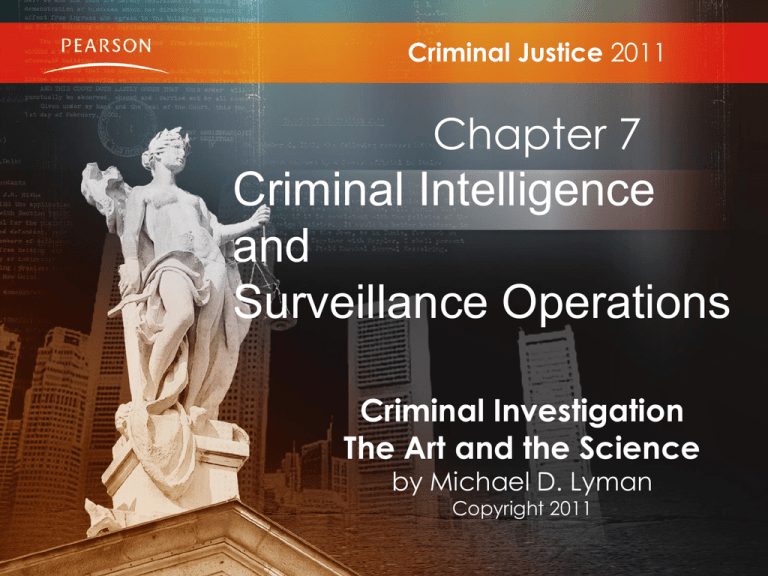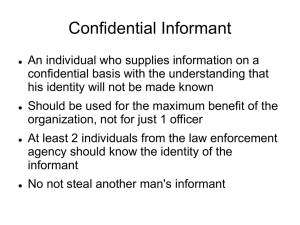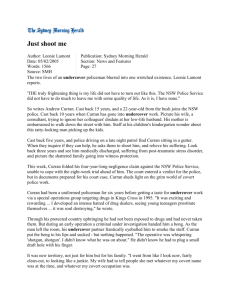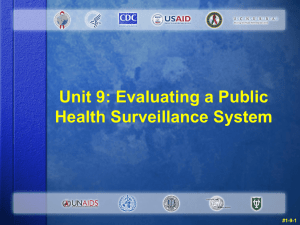Chapter 7
advertisement

Criminal Justice 2011 Chapter 7 Criminal Intelligence and Surveillance Operations Criminal Investigation The Art and the Science by Michael D. Lyman Copyright 2011 CHAPTER SUMMARY 7.1 Understand the roles and types of criminal intelligence. 7.2 Identify the procedures of intelligence collection. 7.3 Explain the types of flowcharting used in intelligence-gathering operations. 7.4 Understand the usefulness of undercover investigations. 7.5 Describe the steps and resources required to properly implement an undercover investigation. 7.6 Explain the types of surveillance in criminal investigation as well as the benefits of a properly conducted intelligence operation. Learning Objectives After this lecture, you should be able to complete the following Learning Outcome 7.1 Understand the roles and types of criminal intelligence 7.1 Overt information Gathering Covert information gathering 7.1 Overt Intelligence Gathering Witness interviews Victim interviews Suspect Interviews Patrol observations and Field Interviews Searches of public records 7.1 Covert Intelligence Gathering Physical surveillance Electronic surveillance Informants Undercover operations 7.1 Types of Leads Physical Evidence Crime Learning Objectives After this lecture, you should be able to complete the following Learning Outcome 7.2 Identify the procedures of intelligence collection. 7.2 The Process…. Intelligence Gathering Photo placeholder 7.2 The Process…. Intelligence Gathering Photo placeholder 7.2 The Process Step 1: Select the Target Step 2: Data Collection Step 3: Data Analysis and Disseminati on Step 4: Preparation for Prosecution 7.2 Intelligence Gathering Technology Advances…. Photo placeholder Learning Objectives After this lecture, you should be able to complete the following Learning Outcome 7.3 Explain the types of flowcharting used in intelligence-gathering operations. 7.3 Analyzing Information Putting the pieces together Photo placeholder 7.3 Analyzing Information 7.3 Sharing Information Intelligence Photo placeholder Learning Objectives After this lecture, you should be able to complete the following Learning Outcome 7.4 Understand the usefulness of undercover investigations. 7.4 Surveillance Methods Foot Surveillance Vehicle Surveillance Stationary Surveillance GPS 7.4 Undercover Operations Getting Evidence vs. Entrapment 7.4 Undercover Flow Chart Identify the target Assign the UC Develop a cover story Begin operation 7.4 Undercover Flow Chart – Part 2 Identify the target Assign the UC Develop a cover story Begin operation Learning Objectives After this lecture, you should be able to complete the following Learning Outcome 7.5 Describe the steps and resources required to properly implement an undercover investigation. 7.5 Undercover Process Reasons for UC as an investigative method Only way to obtain evidence of a crime Prevent the commission of an act or apprehend a suspect in the commission of an act Locate persons or watch their hangouts and associates Obtain probable cause for obtaining search warrants Obtain information for later use in an interrogation Develop leads and information received from other sources 7.5 Undercover Process General procedure Criminal activity discovered Select Target Undercover Intro Obtain evidence Obtain search or arrest warrant Prosecute Learning Objectives After this lecture, you should be able to complete the following Learning Outcome 7.6 Explain the types of surveillance in criminal investigation as well as the benefits of a properly conducted intelligence operation. 7.6 Types of Surveillance Foot Vehicle Stakeout 7.6 Benefits of Surveillance Reasons for surveillance are the SAME as for UC as an investigative method Only way to obtain evidence of a crime Prevent the commission of an act or apprehend a suspect in the commission of an act Locate persons or watch their hangouts and associates Obtain probable cause for obtaining search warrants Obtain information for later use in an interrogation Develop leads and information received from other sources 7.6 Why Use Undercover or Surveillance? Prosecution vs. Unfettered Crime CHAPTER SUMMARY 7.1 Understand the roles and types of criminal intelligence. 7.2 Identify the procedures of intelligence collection. 7.3 Explain the types of flowcharting used in intelligence-gathering operations. 7.4 Understand the usefulness of undercover investigations. 7.5 Describe the steps and resources required to properly implement an undercover investigation. 7.6 Explain the types of surveillance in criminal investigation as well as the benefits of a properly conducted intelligence operation.











